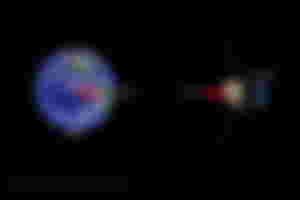A back-of-the-envelope calculation is an informal mathematical computation, often performed on a scrap of paper, such as an envelope. A back-of-the-envelope calculation uses estimated or rounded numbers to develop a ball park figure quickly. The result should be more accurate than a guess, as it involves putting thought to paper, but it will be less accurate than a formal calculation performed using precise numbers and a spreadsheet or calculator.
Let's come to the second part of the question. Not only the earth, but also the moon was pulling the lemon towards itself. Do we have to catch that attraction force in the figure? Let's calculate the acceleration of the lemon (g \ sp {\ prime}) to attract the moon. The calculation of the previous chapter will also apply here. [https://read.cash/@Anindo/can-the-gravity-of-an-object-be-zero-after-a-distance-part-1-e65e8027 Link of part 1] That is,
g\sp{\prime}= \frac{G \cdot M\sp{\prime}}{{R\sp{\prime}}^2}
In this case the mass of the moon is M \ sp {\ prime} = 7.35 \ times 10 ^ {22} kg and the distance of the moon from the earth is R \ sp {\ prime} = 3.84 \ times 10 ^ 8 m. Without first determining a perfect value of g \ sp {\ prime, let us see whether the total g \ sp {\ prime is much smaller than g (g \ sp {\ prime} \ ll g), or very Big (g \ sp {\ prime} \ gg g), or are they pretty close to each other (g \ sp {\ prime} \ approx g)?[Which of these three can you guess exactly?] To quickly calculate a "total", we need the nearest values of G, M \ sp {\ prime}, and R \ sp {\ prime to the power of their nearest 10. Can use :
G = 6.67 \times 10^{-11}m^3kg^{-1}s^2
\approx 10 \times 10^{-11} m^3 kg^{-1} s^2
= 10^{-10} m^3 kg^{-1} s^2
M\sp{\prime} = 7.35 \times 10^{22} kg \ approx 10 \times 10^{22} kg = 10^{23} kg
R\sp{\prime} = 3.84 \times 10^8 kg \ approx 1 \times 10^8 kg = 10^8 kg
Let's put these values in the equation:
g\sp{\prime} \approx \frac{10^{-10} \times 10^{23}}{(10^{8})^2} ms^{-2} = 0.001 ms^{-2}
Phew!!!! 🙄🙄 That`s a lot of equation.🤔🤔
Then it turns out that in the context of our small experiment, the moon is so far away from the earth that its gravity can be considered zero. But keep in mind that this is a contextual truth. If I had a device in my school that could measure t to the fourth place of a decimal, then the gravity of the moon could not be considered zero! Because the difference of 0.001m / s ^ {- 2} will also be caught then.

So it depends on which object's gravitational force I will hold and which I will assume to be zero, depending on which test I am comparing the results with and how precisely that test is going to be performed. If there is a difference in the answer to gravity of an object which cannot be tested by my instrument, then there is no benefit in gravity of that object, perhaps it can be called zero. For example, if the stopwatch can measure decimal numbers in my figure, then the gravity of the moon can be said to be zero in the figure of throwing a lemon.
So to say, "After a certain distance, the gravity of an object becomes zero", does not make sense. It may be said, "It is true that an object has gravity after a certain distance, but the difference in the answer to the sum is small. If I can't measure the slightest difference in my instrument, then there is no benefit in gravity of the object. ” Sometimes things are said simply to facilitate discussion. The same thing applies with “gravity becomes zero”. But to put it simply, a misconception can remain in the head, which can lead to problems in certain cases. For example, if there is a fine time measuring instrument, if there is no gravity of the moon, then there will be a problem.

This type of quick calculation is a great tool for science research. Scientists call this back-of-envelope calculation.🧐🧐 So, Whenever you get the chance to enjoy gravity you should take it like the picture above.😉😉

